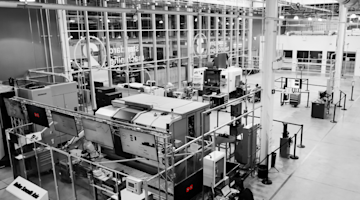In addition to being an engine of economic power and a source of innovation that benefits the entire nation, manufacturing is critical to national security. Innovative new technologies and processes in manufacturing increase productivity, enable new products, and create new industries. Manufacturing is also among the highest-paying sectors of the economy.
Small and medium-sized manufacturers (SMMs) with fewer than 500 employees manufacture most of the components, assemblies, subsystems, and systems that make up complex products in the aerospace, automotive, and oil & gas sectors, and they constitute approximately 95% of U.S. manufacturers. Unfortunately, decades of offshoring have resulted in underinvestment in U.S.-based manufacturing facilities and capabilities; has weakened the resilience of its supply chain, R&D, and innovation; and has reduced the number of jobs in the sector.
There has been a great of deal of research on the relationship between manufacturing, R&D, and innovation in the past decade, including research by Pisano and Shih. The latter pair look at the relationship between the design of products, the design and operation of their corresponding manufacturing processes, R&D, and innovation. They summarize the relationship in their Modernity-Modularity Matrix and show that in some cases, offshoring manufacturing erodes domestic capabilities for innovation.
Additional research by the MIT Production in the Innovation Economy (PIE) research project examines how various product characteristics affect total product cost (TPC) and the decision to offshore. Its premise is that the standard cost model, which only includes the cost of direct production costs (material, labor), transportation costs, and duties, is too simplistic and fails to take into account a variety of other costs which are often critical to making a decision to offshore. These include the cost structure of inventory, costs of handling, the degree of product variety, the ratio of the product value to weight, the impacts of delays, and other factors.
Many countries have recognized the economic benefits of investments in R&D and education and their relationship to innovation and have invested heavily in state-funded initiatives to ensure that economic security, employment, and investment are aligned with strategic national interest. In many cases, they have surpassed the United States in their investments in these areas.
A strategic plan developed by the National Science & ��������ֱ�� Council, , presents a vision for American leadership in advanced manufacturing that ensures national security and economic prosperity. The goals and priorities identified in the strategic plan support the manufacturing industrial base and serve as a guide for both public and private sector investments. The comprehensive report looks at the role of new technologies, public-private partnerships, ecosystems of manufacturing innovation, supply chain growth and resiliency, education and training, and cybersecurity, among many elements.
There seems to be a broad consensus in both the public and private sectors about current economic weaknesses and challenges in the U.S. manufacturing ecosystem. Through policy and federal agencies, the public sector has many resources at its disposal that it can use to encourage investment in technologies or specific sectors of the economy that are deemed critical to the economic strength and resilience of the nation. These include legislation, tax incentives, federal guarantees, and subsidies.
The recent pandemic has made clear the critical role that manufacturing plays in ensuring U.S. national security whether in terms of adequate medical supplies or any other scarce resource such as defense-related supplies. In the future, the United States may look back at the present time and see a pivot toward greater collaboration between the public and private sectors and an overall greater emphasis on national security in all its forms.
To learn more about the challenges the United States faces and the key research that guides some of the current policy solutions, access the full white paper .









